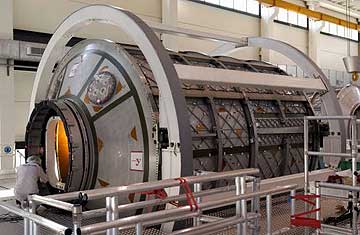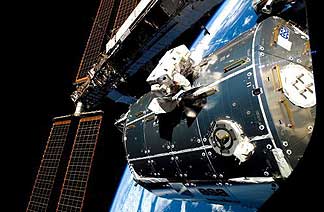
Employee, Space (DSP), working on Columbus module assembly on March 27, 2007. As ISS (International Space Station) element, Columbus, research laboratory, structured on the basis of the MPLM (Multi-Purposes Logistics Module) design, will be a perfectly pressurised and habitable environment, as is every other crew area on the ISS, and will be able to host two crew members.Copyright: ©THALES ALENIA SPACE
Astrium, Europe’s leading space company, developed and built Columbus as prime contractor to the European Space Agency (ESA). “These two years of trouble-free operation, clearly demonstrate our team's excellent and efficient work – and illustrate how to achieve outstanding cooperation between scientific research and industry,” commented Helmut Luttmann, Head of Operations & Missions for the ISS at Astrium, marking Columbus' second anniversary.
Columbus was the first space laboratory to be fully equipped on the ground, enabling scientific work to begin a few days after its launch on February 2008. One of the first experiments, carried out by Brandenburg Technical University Cottbus under the name “GEOFLOW”, was so successful that it is set to continue as “GEOFLOW 2” at the end of the year.

ESA astronaut Hans Schlegel working on Columbus exterior during the second spacewalk of the STS-122 mission. As ISS (International Space Station) element, Columbus, research laboratory, structured on the basis of the MPLM (Multi-Purposes Logistics Module) design, will be a perfectly pressurised and habitable environment, as is every other crew area on the ISS, and will be able to host two crew members.Copyright: ©ESA- NASA
On one of the latest experiments, Astrium therefore handled preparations to mount the Vessel ID technology experiment on Columbus’ exterior. Astronauts Michael Foreman and Randolph Bresnik subsequently installed the external unit last November. It features a VHF antenna to pick up signals, via a transponder, from all international vessels over 300 tons, all container ships over 500 tonnes and all passenger vessels. Their location can be pinpointed at all times.
On behalf of ESA, Astrium is responsible for the key European elements of the ISS. These include the European research laboratory Columbus and the Automated Transfer Vehicle (ATV). Astrium is also the industrial prime contractor for operation and utilization of European contributions to the ISS. Currently six Astrium-built multi- user experiment facilities are on board the ISS.

